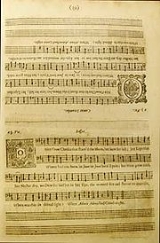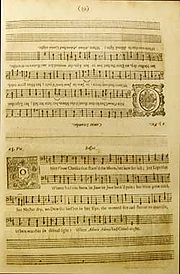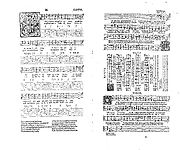
Table-book
Encyclopedia

Manuscript
A manuscript or handwrite is written information that has been manually created by someone or some people, such as a hand-written letter, as opposed to being printed or reproduced some other way...
or printed book which is arranged so that all the parts of a piece of music can be read from it while seated around a table. They were made in the 16th and 17th century for both instrumental and vocal pieces. They are an extension of the idea of Choir books, in which all parts are displayed on one page, in contrast with partbook
Partbook
A partbook is a format for printing or copying sheet music in which each book contains the part for a single voice or instrument, especially popular during the renaissance and baroque. This is in contrast to the large choirbook which could be shared by an entire choir, and appears to have been a...
s, which have a different book for each part (one book for all the soprano parts, another for all the altos, etc.) and each performer has their own book.
The first example of such a book is probably Le parangon des chansons (1538) by Jacques Moderne
Jacques Moderne
Jacques Moderne was an Italian-born music publisher active in France in the Renaissance Era....
of Lyon
Lyon
Lyon , is a city in east-central France in the Rhône-Alpes region, situated between Paris and Marseille. Lyon is located at from Paris, from Marseille, from Geneva, from Turin, and from Barcelona. The residents of the city are called Lyonnais....
. There are far more English than Continental examples of this type of book. English sources contain many lute pieces and works by John Dowland
John Dowland
John Dowland was an English Renaissance composer, singer, and lutenist. He is best known today for his melancholy songs such as "Come, heavy sleep" , "Come again", "Flow my tears", "I saw my Lady weepe" and "In darkness let me dwell", but his instrumental music has undergone a major revival, and has...
, including his Lachrimae.
The books began displaying duets, and later quartets. Later systems of displaying parts worked for up to six performers, and in extreme cases as many as 12.

Peter Short (printer)
Peter Short was a London printer of the later Elizabethan era. He printed several first editions and early texts of Shakespeare's works....
published 30 lute song
Lute song
The lute song was a generic form of music in the late Renaissance and very early Baroque eras, generally consisting of a singer accompanying himself on a lute, though lute songs may often have been performed by a singer and a separate lutenist...
books in the table-book format, many of them containing Dowland's music, beginning in 1597.

